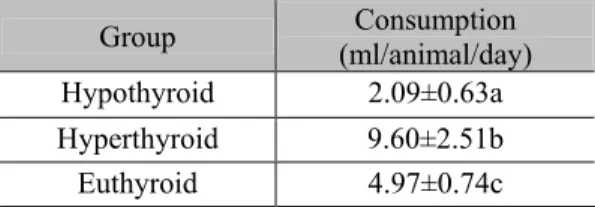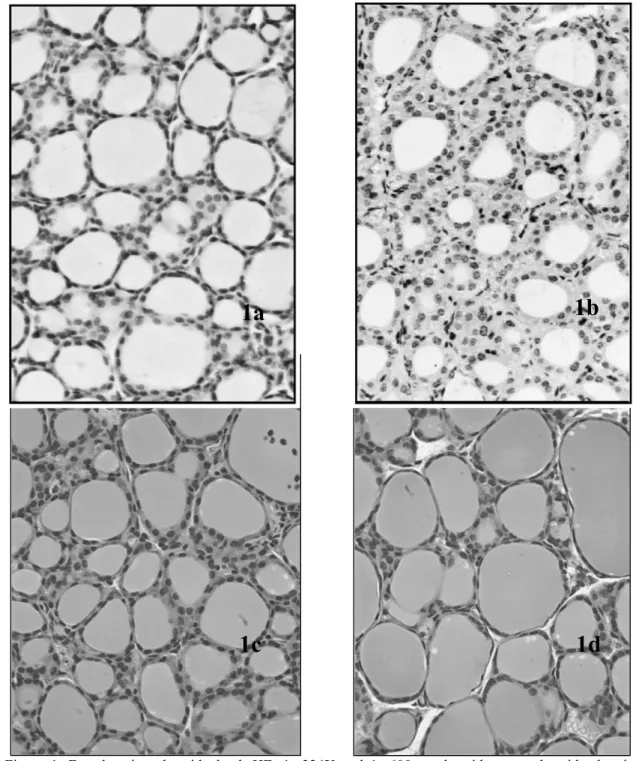Model of induction of thyroid dysfunctions in adult female mice
[Modelo de indução de disfunções tireoidianas em camundongos fêmeas adultas]
E.Ferreira1, A.E. Silva1, R. Serakides2, A.E.S. Gomes1, G.D. Cassali1*
1
Instituto de Ciências Biológicas - UFMG Caixa Postal 486
31270-901 – Belo Horizonte, MG
2
Escola de Veterinária - UFMG – Belo Horizonte, MG
ABSTRACT
It is described the elaboration of a protocol to induce hyperthyroidism and hypothyroidism in mice by administrating thyroxin and propylthiouracil, respectively, in the drinking water. The drugs were administered to adult female mice of the Swiss strain for 30 days in order to obtain a systemic status of thyroid dysfunction. The induction of hyperthyroidism and hypothyroidism in the animals was confirmed by the histomorphological analysis of the thyroid in the end of the experiment, when the state of gland dysfunction in the animals submitted to the treatment was observed.
Keywords: mouse, thyroid, protocol, induction, thyroxin, propylthiouracil
RESUMO
Descreve-se a elaboração de um novo protocolo de indução ao hipertireoidismo e hipotireoidismo em camundongos, por meio da administração de tiroxina e propiltiouracil, respectivamente, na água de beber. As drogas foram administradas a camundongos fêmeas adultas Swiss por 30 dias para obtenção das disfunções tireoidianas sistêmicas. A indução de hipertireoidismo e hipotireoidismo nos animais foi confirmada pela análise histomorfológica e histomorfométrica da glândula tireoidiana ao final do experimento, quando observou-se o estado de disfunção glandular nos animais submetidos ao tratamento.
Palavras-chave: camundongo, tireóide, protocolo, indução, tiroxina, propiltiouracil
INTRODUCTION
Triiodothyronine (T3) and thyroxin (T4) hormones are known as cell metabolism regulators, being associated with different biological processes in all vertebrates (Shi et al., 2002; Nunes, 2003).
Thyroid dysfunctions are considered as some of the most important endocrinopathies both in human (Shi et al., 2002) and in veterinary medicine (Rijnberk et al., 2003).
Recebido em 17 de abril de 2006 Aceito em 3 de setembro de 2007
*Autor para correspondência (corresponding author)
Hyperthyroidism is the most common endocrine disease in women (Goldman, 1990), and hypothyroidism may occur in individuals of all ages affecting several different organs and systems (Ishikawa et al., 1998).
thyroxin administration in high doses promoting an iatrogenic hyperthyroidism status (Kobayashi et al., 2000; Serakides et al., 2002; 2005). However, most studies recommend the use of traumatic methods and protocols, as for hormone dosage or the induction methodology using rats as animal model. A suggestive resistance to induction of hypothyroidism in mice is described in the literature, for unknown reasons (Hardisty and Boorman, 1999).
In the literature, no protocol using adult mice in thyroid dysfunction studies was found, which unables an appropriate standardization of experimental hypothyroidism or hyperthyroidism induction in these animals. The use of mice in certain studies, as “knockout” animals or hosts for specific tumors, reinforces the need of standardizing the model of inducing thyroid dysfunction proposed in this work.
The main purpose of this work was to establish a protocol to induce hyperthyroidism and hypothyroidism in adult female mice, in a simple and practical way, in order to obtain an experimental model.
MATERIAL AND METHODS
Thirty three-month-old female mice were kept in plastic boxes (10 animals/box), where they received commercial concentrate food and water ad libitum. Mice were submitted to a regimem of 12 hours of light and 12 hours of darkness. Animals were distributed in three groups of 10, a hyperthyroid group, a hypothyroid one, and a third one maintained as control.
The animals of the hyperthyroid group received L-thyroxin daily at a dose of 2Pg/ml, diluted in drinking water. Animals of the hypothyroid group received propylthiouracil (PTU) at a dose of 1mg/ml, diluted in drinking water similar to the hyperthyroid group. The control group received distillate water. Drugs were administered for 30 days in an attempt to obtain a clinical-physiological status of thyroid dysfunction in the animals. L-thyroxin and PTU dose ingested daily by each animal was estimated by subtracting the daily quantity of water drunk from the quantity of water
The body weight was measured in the beginning and in the end of the treatment, in order to observe the animals development by drug ingestion.
After 30 days, animals were sacrificed and necropsied. Thyroids were inspected and processed to certify PTU and L-thyroxin effects on the gland morphology.
Thyroids were fixed in neuter formol and buffered with 10% phosphate, and processed according to the routine technique of paraffin inclusion (Prophet et al., 1992). Histological sections of 4Pm were stained using the hematoxylin-eosin technique (Luna, 1968) for morphological assessment, where mainly the height of follicular epithelium, the size of follicles, the intensity and density of colloid were observed. The mean height of the follicular epithelium was obtained by measuring the 30-follicle epithelium in four different points with the help of an ocular micrometric and 100x lens. A randomized design was used with three treatments and 10 repetitions per treatment, each animal undergoing one repetition. Means were compared by the Student-Newman-Kewls test, considering the level of significance as less than 5% (Sampaio, 2002).
RESULTS AND DISCUSSION
In the beginning of the experiment, animals which received propylthiouracil reduced dramatically the water consumption, forcing changes in the methodology, adding aspartame as sweetener in water (10 drops/100ml), thus reestablishing the water ingestion.
As described in the literature, mice are resistant to PTU, for unknown reasons, thus they need a much higher dose to induce hypothyroidism (Hardisty and Boorman, 1999). Serakides et al. (2005) obtained positive result of hyperthyroid induction in rats after administering 50Pg of L-thyroxin/animal/day, for 30 days. This dosage for mice is likely to lead to an intoxication status, as it is a synthetic hormone and its action in the organism is dose-dependent. The fact that the mice weight is much lower than the weight of the rats should also be considered.
Table 1. Mean and standard deviation of ingestion of water in hypothyroid and hyperthyroid and euthyroid female mice
Group Consumption
(ml/animal/day)
Hypothyroid 2.09±0.63a
Hyperthyroid 9.60±2.51b
Euthyroid 4.97±0.74c
Same letters in the same row indicate no difference (SNK test - P>0,05).
Table 2. Mean and standard deviation of consumption of drugs in hypothyroid and hyperthyroid female mice
Group Consumption
Hypothyroid 2.20±0.61mg of
PTU/animal/day Hyperthyroid 20.49±4.70Pg of
L-Thyroxin/animal/day
The weight gain was observed in euthyroid and hyperthyroid animals and body weight loss was observed in hypothyroid animals. However, means of body weight of the three studied groups did not present any statistical difference. In the thyroid hypofunction, an increase of protean catabolism occurred, with a consequent reduction of muscle mass; synthesis of proteins, vitamins, growth factors; reduction of intestinal absorption of carbohydrates; in addition to osteopenia (Allain et al., 1995). Thus, the reduction of body weight in hypothyroid animals was already
expected. Changes in the body mass of animals with thyroid dysfunctions are probably associated with a longer period of disease occurrence and, supposedly, the induction period has not allowed the observation of such occurrence in this study.
Morphologically, thyroids of the euthyroid group were apparently normal, showing round or oval follicles, with different sizes and coated, most of the times, by low cuboidal epithelium and filled with little vacuolated and little dense colloid. There were also large follicles, in a smaller number, lined by flattened epithelium (Fig. 1a and 1c).
In animals treated with PTU, thyroids presented altered follicles and with varied sizes, filled by a variable quantity of little dense and very vacuolated colloid. Coating cells were cuboidal and sometimes columnar, with a sometimes eosinophilic and sometimes vacuolated cytoplasm and large and hypochromatic nuclei. There were also pools of follicular cells devoid of lumen (interfollicular adenomatosis) and follicles coated by one or more layers of cells forming papillary projections for the lumen (intrafollicular adenomatosis) (Fig. 1b). These findings confirm the action of PTU on thyroid and, consequently, the success of the hypothyroidism induction, having in mind that morphological analysis of thyroid has been described by several authors as a good indicator of antithyroid drugs (Haschek and Rousseaux, 1991; Serakides et al., 1999).
Figure 1. Female mice, thyroid gland. HE. 1a-324X and 1c-600x euthyroid group: thyroids showing round or oval follicles, with different sizes and coated, most of the times, by low cuboidal epithelium and filled with little vacuolated and little dense colloid. 1b- 324x hypothyroid group: thyroids presented altered follicles and with varied sizes, filled by a variable quantity of little dense and very vacuolated colloid. There were also pools of follicular cells devoid of lumen (interfollicular adenomatosis). 1d-600x hyperthyroid group: thyroids presented follicles of several sizes containing a large quantity of colloid, being coated by flattened epithelium, and visibly smaller than those of the other groups.
1a
1d
1c
Morphometric analysis confirmed different statuses of thyroid dysfunction in the studied groups, showing a significant increase in the height of the follicular epithelium in the hypothyroid group and its significant decrease in hyperthyroid animals when compared to the control group (Table 3) (P<0.05).
Table 3. Mean and standard deviation of morphometric analysis of the follicular epithelium (Pm) in hypothyroid, hyperthyroid and euthyroid female mice
Hypothyroid Hyperthyroid Euthyroid 12.10±2.14a 2.31±0.22b 3.7±0.28c Same letters in the same row indicate no difference (SNK test - P>0.05)
ACKNOWLEDGMENTS
This work was partially supported by grants from CNPq and FAPEMIG.
CONCLUSION
This study allowed elaborating an experimental protocol of thyroid dysfunctions in adult female mice, which has not been previously described in the literature. Thyroid histological analysis confirmed thyroxin action in the induction of hyperthyroidism and propylthiouracil action in the induction of hypothyroidism in mice. In addition, the administration of drugs in the drinking water was an effective and practical procedure, and with little animal handling, important factors when using animals as experimental models.
REFERENCES
ALLAIN, T.J.; THOMAS, M.R.; MCGREGOR, A.M. et al. A histomorphometric study of bone chances in thyroid dysfunction in rats. Bone, v.16, p.505-509, 1995.
FERREIRA, E.; SERAKIDES, R.; NUNES, V.A. et al., Morfologia e histoquímica da pele de ratas hipotireóideas castradas e não castradas. Arq. Bras. Med. Vet. Zootec., v.55, p.51-60, 2003.
GOLDMAN, M.B. Thyroid diseases and breast cancer.
Epidemil. Rev., v.12, p.16-28, 1990.
HARDISTY, J.F.; BOORMAN, G.A. Thyroid and parathyroid glands. In: MARONPT, R. R. (Ed).
Pathology of the mouse. Cache River, 1999. p.537-554.
HASCHEK, W.N.; ROUSSEAUX, C.G. (Eds).
Handbook of toxicology pathology. San Diego: Academic, 1991.
ISHIKAWA, Y.; GENGE, B.R.; WUTHIER, R.E. Thyroid hormone inhibits growth and stimulates terminal differentiation of epiphyseal growth plate chondrocytes.
J. Bone Miner. Res., v.13, p.1398-1411, 1998.
KHOTIMCHENKO, Y.S.; SERGUSHCHENKO, I.S. Comparative efficiency of low-esterified pectin and antistrumin during experimental hypofunction of the thyroid gland. Bull. Exp. Biol. Med., n.6, p.566-568, 2003.
KOBAYASHI, R.; SHIMOMURA, Y.; OTSUKA, M. et al. Experimental hyperthyroidism causes inactivation of the branched-chain a-ketoacid dehydrogenase complex in rat liver. Arch. Biochem. Bioph., v.375, p.55-61, 2000.
LUNA, L.G. (Ed). Manual of histologic staining methods of the Armed Forces Institute of Pathology. 3 ed. New York: Mac Graw Hill, 1968.
McCARDLE, A.; HELLIWELL, T.R.; BECKETT, G.J. et al. Effect of propylthiouracil-induced hypothyroidism on the onset of skeletal muscle necrosis in dystrophin-de®cient mdxmice. Clin. Sci., v. 95, p.83-89, 1998.
NUNES, M.T., Hormônios tiroideanos: mecanismo de ação e importância biológica. Arq. Bras. Endocrinol. Metabol., v.47, p.639-643, 2003.
PROPHET, E.B.; MILLS, B.; ARRINGTON, J.B. et al.
AFIP laboratory methods in histotechnology.
Washington: American Registry of Pathology, 1992.
RIJNBERK, A.; KOOISTRA, H.S.; JAN MOL, A. Endocrine diseases in dogs and cats: similarities and diferences with endocrine diseases in humans. Growth Horm. IGF Res., v. 13, p.S158-S164, 2003.
SAMPAIO, I.B.M. Estatística aplicada à experimentação animal. 2.ed. Belo Horizonte: FEPMVZ, 2002. 265p.
SERAKIDES, R.; NUNES, V.A.; SILVA, C.M. et al. Influência do hipogonadismo na histomorfometria e função tireoidiana de ratas hipotireóideas. Arq. Bras. Med. Vet. Zootec.,v.54, p.473-477, 2002
SERAKIDES, R.; NUNES, V.A.; SANTOS, R.L. et al., Histomorphometry and quantification of nucleolar organizer region (NORs) in bovine thyroid containg methyltiouracil residues. Vet. Pathol., v.36, p.574-582, 1999.
SERAKIDES, R.; OCARINO, N.M.; CARDOSO, J.R.C. et al. Resposta da paratireóide de ratas às variações do cálcio e fósforo plasmático no hipertireoidismo e hipogonadismo.Arq. Bras. Med. Vet. Zootec., v.57, p.48-54, 2005.
SHI, Y.; RITCHIE, J.W.A.; TAYLOR, P.M. Complex regulation of thyroid hormone action: multiple opportunities for pharmacological intervention.
Pharmacol. Therap., v.94, p.235-251, 2002.

